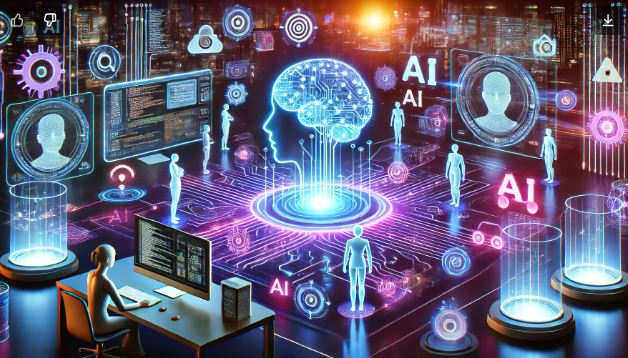Next-Gen Generative AI: Unveiling the Future with OpenAI’s ChatGPT and Meta’s Llama Models
The field of generative AI has experienced explosive growth since the release of OpenAI’s ChatGPT in late 2022, marking the dawn of a new era in artificial intelligence. The rapid evolution from the initial launch of ChatGPT to its current advanced iteration, ChatGPT 5, coupled with Meta’s open-source Llama 3 model, showcases the relentless pace of innovation. Together, these next-gen AI models are reshaping industries, transforming workflows, and providing unprecedented opportunities for businesses and developers alike.

The Journey of Generative AI: From Chatbots to Complex Reasoning
When ChatGPT first emerged, it gained attention for its ability to simulate human-like conversations. However, it didn’t stop there. With each upgrade, OpenAI has improved the AI’s ability to reason, plan, and handle increasingly complex tasks. ChatGPT 5 now demonstrates a level of understanding that enables it to perform more than just basic text generation, with a significant focus on multi-modal capabilities. This allows it to handle inputs beyond text, such as images, audio, and even videos. Similarly, Meta’s Llama models are pushing the boundaries of open-source AI, with Llama 3 focusing on democratizing access to cutting-edge generative AI for developers and researchers around the globe.Both models now have a broader application scope, from summarizing research papers and automating programming tasks to assisting with personalized learning and creative design.
Tackling the Challenges: Bias, Hallucinations, and Ethical Concerns
One of the most significant challenges for generative AI has been addressing the biases and hallucinations that arise during its use. These issues occur when the AI either provides inaccurate or biased information, a concern that has garnered attention from both developers and regulators. OpenAI, Meta, and other major players are working hard to ensure that these biases are mitigated through extensive retraining and enhanced datasets.For instance, efforts are underway to reduce bias in AI-generated images, as previous iterations of AI tools like Google’s Gemini faced criticism for presenting outdated Western stereotypes when asked to depict certain groups or cultures. Both ChatGPT 5 and Llama 3 are also incorporating features that improve the model’s decision-making ability by analyzing not just the data but also the broader context of its usage. This is crucial in tackling ethical concerns, such as ensuring the AI does not reinforce harmful stereotypes or make discriminatory predictions.
The Rise of Multi-Modal Generative AI
One of the groundbreaking advancements in next-gen AI is the incorporation of multi-modal capabilities. The ability for AI models to process different types of inputs—such as text, images, audio, and even videos—enables the creation of tools that can engage more meaningfully with human activities. Imagine an AI that can design a website by understanding not just written instructions but also visual layouts, or a virtual assistant that can analyze video content and summarize it for you in seconds. These advancements will open new frontiers in creative industries, healthcare, education, and beyond.Meta’s Llama 3, being an open-source model, offers developers the flexibility to customize and innovate, fostering community-driven improvements and allowing for more niche applications in AI. This could lead to more AI-driven solutions tailored for specific industries such as architecture, medicine, and even finance.
Hypothetical Calculations: The Impact on Productivity
Let’s look at some hypothetical numbers to see how generative AI might revolutionize productivity in the workplace:
Suppose a company spends 200 hours a month on content creation for its marketing campaigns. With generative AI like ChatGPT 5, this time could be reduced by 70% due to the automation of brainstorming, drafting, and revising content.Sample Calculation:If the company typically invests $50 per hour for content creation:
- Current Cost: 200 hours * $50/hour = $10,000AI-Assisted Cost: 60 hours (30% of 200 hours) * $50/hour = $3,000
Savings: $10,000 – $3,000 = $7,000This is a simple but illustrative calculation of how integrating generative AI into workflows can lead to significant cost and time savings while enhancing the quality and quantity of the output.
Future Predictions: Where Do We Go From Here?
The future of generative AI holds exciting possibilities. Here are some astonishing predictions:
AI-Driven Hyper-Personalization: As models become more advanced, businesses will use generative AI to deliver hyper-personalized experiences. From e-commerce to healthcare, AI will tailor every interaction to individual needs, optimizing services like never before.AI-Assisted Decision Making: AI models like ChatGPT and Llama will evolve to the point where they not only provide recommendations but actively participate in decision-making processes, weighing multiple variables and offering strategic insights.Expanding to Physical Spaces: We are likely to see generative AI models move beyond digital realms. Robots powered by AI engines could assist in construction, agriculture, and even space exploration by generating solutions in real-time based on the evolving environment.AI Collaboration on Scientific Discoveries: In the next decade, generative AI models could be co-authors of scientific papers, collaborating with human researchers to generate hypotheses, design experiments, and even interpret complex datasets.
Conclusion
The convergence of OpenAI’s ChatGPT and Meta’s Llama models marks the dawn of a new era in generative AI. As these technologies continue to evolve, their potential applications will broaden, impacting nearly every sector of society. From addressing ethical challenges to enhancing productivity through multi-modal capabilities, the future of generative AI is bright, and its full potential is only beginning to unfold.Excerpt:Next-gen generative AI models like OpenAI’s ChatGPT and Meta’s Llama are transforming industries with their advanced capabilities, driving automation and innovation forward.LinkedIn Post:🚀 Unlocking the Future of Generative AI 🚀OpenAI’s ChatGPT 5 and Meta’s Llama 3 are paving the way for unprecedented advancements in AI. From reducing bias and enhancing multi-modal capabilities to driving productivity gains, these models are set to transform industries across the globe. Dive deep into how this technology is shaping the future! 🌐 Read more: [Insert Blog Link] #GenerativeAI #OpenAI #Meta #AIInnovation #Llama3 #ChatGPT #TechTrends #QAppFeatured Image:For the featured image, envision a futuristic, sleek AI interface glowing in neon hues. The AI’s components process streams of diverse inputs (text, images, audio) that merge into a digital neural network. In the background, human figures interact seamlessly with AI assistants on various screens, symbolizing the future of AI-driven collaboration across multiple industries. (1792x1024px)Let me know if you’d like any adjustments!


